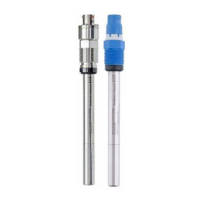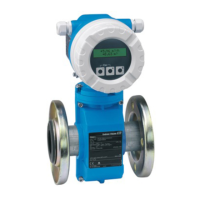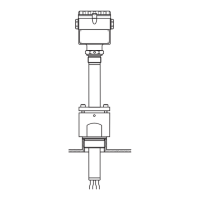Device description, function Oxymax COS22
6 Endress+Hauser
3 Device description, function
3.1 Amperometric measuring principle
The oxygen molecules that diffuse through the membrane are reduced at the cathode to
hydroxide ions (OH-). At the anode, silver is oxidized to silver ions (Ag+) (this forms a
silver halide layer). A current flows due to the electron donation at the cathode and the
electron acceptance at the anode. Under constant conditions, this flow is proportional to
the oxygen content of the medium. This current is converted in the transmitter and
indicated on the display as an oxygen concentration in mg/l, µg/l, ppm, ppb or Vol%, as a
saturation index in % SAT or as an oxygen partial pressure in hPa.
3.2 Sensor design
A0011868
1 COS22
1
2
3
Plug-in head
Thrust collar
Sensor shaft
4
5
6
O-ring 8.5 x 1.5 mm
Membrane body
Shaft sleeve
7
8
9
Glass portion with anode and cathode
Process seal 10.77 x 2.62 mm
Process connection Pg 13.5
3.3 Membrane body
The oxygen dissolved in the medium is transported to the membrane by the necessary
flow. The membrane is permeable for dissolved gases only. Other substances dissolved in
the liquid phase, e.g. ionic substances, will not penetrate through the membrane.
Therefore, medium conductivity has no impact on the measuring signal.
The sensor is shipped with a standard membrane body, which can be used for all common
applications. The membrane is pretensioned at the factory and can be installed
immediately.
Electrolytes are version-specific and cannot be mixed in a single application!
3.4 Polarization
When the sensor is connected to the transmitter, a fixed voltage is applied between the
cathode and anode. The polarization current this creates can be identified on the
transmitter with a display that is initially high, but decreases with time. The sensor cannot
be calibrated until the display is calibrated.
Reference value for nearly complete polarization of a sensor that was previously stored for
a long time:
• COS22-*1: 2 hours
• COS22-*3: 12 hours
After this time, even measurements close to the determination limit are useful. The
necessary polarization time is reduced for sensors that were in use a short time before.

